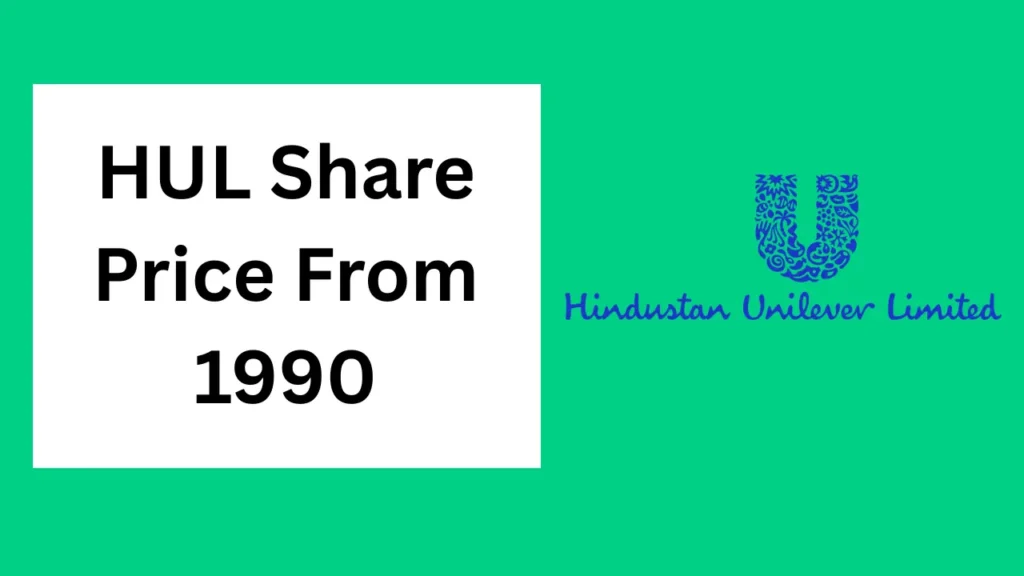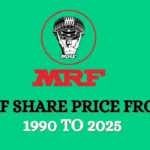Hindustan Unilever Limited (HUL) is one of India’s most iconic FMCG companies, with a strong portfolio that includes products in personal care, home care, and food & beverages. Investors and market enthusiasts often track HUL’s share price to understand long-term growth trends, market resilience, and investment potential. Over the past three decades, HUL has not only delivered consistent returns to shareholders but has also evolved as a benchmark for stability in India’s stock market.
In this post, we provide a year-wise table of HUL share price from 1990 to 2025, along with detailed insights on the stock’s historical performance, bonus history, and investment value.

HUL Share Price Year-wise (BSE)
| Years | Share Price (₹) |
|---|---|
| 1990 | 14 |
| 1991 | 14 |
| 1992 | 20 |
| 1993 | 35 |
| 1994 | 69 |
| 1995 | 57 |
| 1996 | 64 |
| 1997 | 91 |
| 1998 | 144 |
| 1999 | 194 |
| 2000 | 285 |
| 2001 | 217 |
| 2002 | 224 |
| 2003 | 191 |
| 2004 | 218 |
| 2005 | 160 |
| 2006 | 200 |
| 2007 | 226 |
| 2008 | 244 |
| 2009 | 267 |
| 2010 | 268 |
| 2011 | 329 |
| 2012 | 411 |
| 2013 | 535 |
| 2014 | 584 |
| 2015 | 967 |
| 2016 | 868 |
| 2017 | 875 |
| 2018 | 1415 |
| 2019 | 1860 |
| 2020 | 2085 |
| 2021 | 2456 |
| 2022 | 2424 |
| 2023 | 2692 |
| 2024 | 2669 |
| 2025 | 2478 |
Key Insights from HUL Share Price History
1. Consistent Long-term Growth
HUL’s share price has shown remarkable growth from ₹14 in 1990 to ₹2,478 in 2025. Despite market fluctuations and economic cycles, the stock has maintained an upward trajectory over the long term. This growth reflects the company’s strong fundamentals, brand recognition, and dominance in the FMCG sector.
Also Read: MRF Share Price History (1990–2025) – Journey to ₹1 Lakh+
2. Dividend Payouts
HUL has consistently paid dividends, reflecting its strong cash flow and commitment to shareholder returns. Over the years, dividends have formed an important part of total shareholder returns, complementing capital appreciation.
3. Key Milestones in Share Price History
- 1990–2000: HUL’s share price rose steadily as India liberalised its economy and consumer spending increased. The stock price jumped from ₹14 to ₹285 over the decade.
- 2000–2010: Despite market volatility, HUL maintained stable growth. Strategic brand expansion and product innovation helped sustain investor confidence.
- 2010–2020: This decade marked significant growth for HUL, with the share price crossing ₹2,000 in 2020. The stock performed strongly due to new product launches, increased urbanisation, and a robust FMCG market.
- 2020–2025: Even amid global economic challenges, HUL’s share price remained resilient, reflecting its diversified product portfolio and strong market positioning.
4. Investment Returns
Investing in HUL in 1990 would have yielded massive returns by 2025. For example, a ₹10,000 investment in 1990, assuming reinvestment of dividends and bonus shares, would be worth over ₹18 lakh today, demonstrating the power of long-term equity investing in blue-chip companies.
HUL Investment Calculator (1990–2025)
Why HUL is a Reliable Long-term Investment
- Market Leadership: HUL is a market leader in multiple FMCG categories, including personal care, home care, and food & beverages.
- Strong Brand Portfolio: Brands like Dove, Lux, Surf Excel, and Lifebuoy ensure a consistent revenue stream.
- Robust Financials: HUL maintains strong profitability, low debt, and high cash flows, making it a safe investment.
- Consistent Dividend Policy: Regular dividends provide steady income to shareholders, enhancing total returns.
- Resilient During Crises: The stock has historically withstood economic downturns, demonstrating stability and resilience.
Conclusion
Hindustan Unilever Limited’s share price history from 1990 to 2025 showcases long-term growth, stability, and consistent shareholder returns. Investors seeking a reliable and steady investment in the FMCG sector can view HUL as a benchmark stock in India’s equity markets.
Tracking the year-wise share price provides valuable insights into market trends, economic impact on consumer goods, and HUL’s performance across decades. With a strong brand portfolio, robust financial health, and consistent dividend payouts, HUL remains a preferred stock for long-term investors.
FAQs – HUL Share Price & Investment
1. What was HUL’s share price in 1990?
HUL’s share price on BSE in 1990 was ₹14 per share.
2. How has HUL’s share price grown over the years?
From ₹14 in 1990, HUL’s share price increased to ₹2,478 in 2025, reflecting long-term growth and stable performance.
3. Does HUL pay dividends?
Yes, HUL consistently pays dividends, contributing to total shareholder returns along with capital appreciation.
4. How can I calculate my HUL investment value?
You can use the HUL Investment Calculator above. Enter your investment amount and the year of investment to see its approximate value in 2025.
5. Is HUL a good long-term investment?
HUL is considered a reliable long-term investment due to its strong market leadership, diverse brand portfolio, consistent dividends, and resilience during economic downturns.




